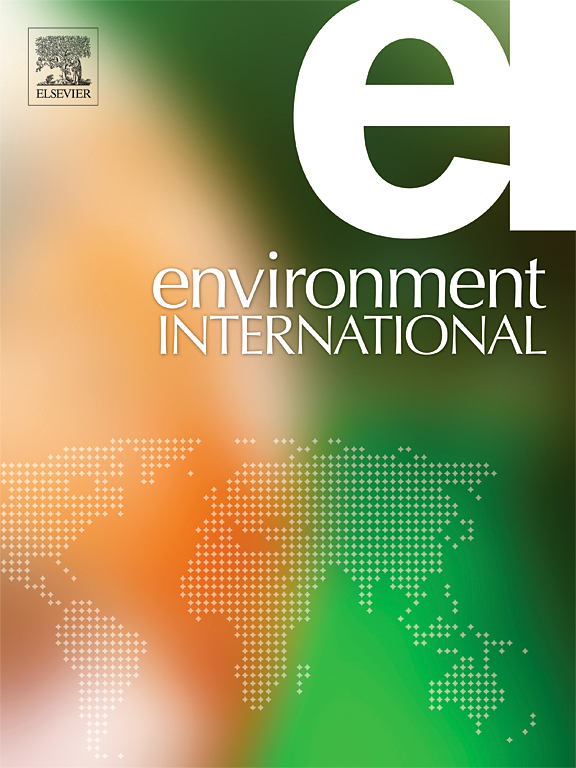按运输类别和车辆类型划分的与空气污染有关的健康风险:死亡率指标的比较
IF 9.7
1区 环境科学与生态学
Q1 ENVIRONMENTAL SCIENCES
引用次数: 0
摘要
交通运输面临着可持续、节能和无污染服务需求的挑战。环境流行病学已经证实,交通细颗粒物(PM2.5)和二氧化氮(NO2)对健康有重大影响,但新出现的证据表明,黑碳(BC)、超细颗粒物(UFP)和二次有机气溶胶(SOA)造成了额外的负担。我们的目标是概述欧盟27国在2030年实施大部分现行立法后仍存在的潜在运输部门空气污染健康风险。方法我们扩展了已建立的排放-摄入效应框架,并应用不同车型的暴露效率和根据每种污染物的流行病学相对风险估计的使用效应因子来计算不同车型、燃料和非废气排放的可归因死亡率。我们的研究结果表明,到2030年,来自交通部门的初级细颗粒物(pm2.5)排放可能仍会导致欧盟27国10,296人(95% CI 7,867-11,476)过早死亡。与其他空气污染指标相比,二氧化氮的估计值为18,686(9,436-36,654),黑碳的估计值为5,037(2,446-7,620),二次有机气溶胶的估计值为1,476(1,017-1,956)。然而,最大的单一污染物死亡率估计是超细颗粒(37,582(31,569-43,219))。道路交通和柴油废气是主要的排放源。这些排放似乎是针对有效控制政策的核心。然而,毒理学证据需要与目前基于流行病学的多污染物指标相结合。在解释这些结果时,应考虑到五种污染物的流行病学证据的变化程度和一致性。本文章由计算机程序翻译,如有差异,请以英文原文为准。


Health risks related to air pollution by transport categories and vehicle types: Comparison by mortality indicators
Background
The transports are challenged by the need of sustainable, energy-efficient, and pollution-free services. Environmental epidemiology has confirmed substantial health impacts from traffic fine particles (PM2.5) and nitrogen dioxide (NO2), but emerging evidence suggests additional burden due to black carbon (BC), ultrafine particles (UFP), and secondary organic aerosols (SOA). Our aim is to make an overview of the potential transport sector air pollution health risks remaining after implementing most of the current legislation by EU27 in 2030.
Methods
We extend the established emission-intake-effect framework and apply exposure efficiencies by vehicle types and use effect factors estimated from epidemiological relative risks for each pollutant to calculate attributable mortalities by vehicle types, fuels, and non-exhaust emissions.
Results
Our results suggest that in 2030, primary fine particle (pPM2.5) emissions from the transport sector may still be responsible for 10,296 (95% CI 7867–11,476) premature deaths in EU27. When compared with alternative air pollution indicators, estimates were 18,686 (9436–36,654) for nitrogen dioxide, 5037 (2446–7620) for black carbon, and 1476 (1017–1956) for secondary organic aerosols. However, largest single pollutant mortality estimate was calculated for ultrafine particles (37,582 (31,569–43,219)). Road traffic and diesel exhausts stand out as dominant sources.
Discussion
These emissions seem central for targeting effective control policies. However, toxicological evidence needs to be incorporated with the current epidemiology-based multipollutant indicators. Variable extent and consistency of epidemiological evidence on the five pollutants should be considered when interpreting these results.
求助全文
通过发布文献求助,成功后即可免费获取论文全文。
去求助
来源期刊

Environment International
环境科学-环境科学
CiteScore
21.90
自引率
3.40%
发文量
734
审稿时长
2.8 months
期刊介绍:
Environmental Health publishes manuscripts focusing on critical aspects of environmental and occupational medicine, including studies in toxicology and epidemiology, to illuminate the human health implications of exposure to environmental hazards. The journal adopts an open-access model and practices open peer review.
It caters to scientists and practitioners across all environmental science domains, directly or indirectly impacting human health and well-being. With a commitment to enhancing the prevention of environmentally-related health risks, Environmental Health serves as a public health journal for the community and scientists engaged in matters of public health significance concerning the environment.
 求助内容:
求助内容: 应助结果提醒方式:
应助结果提醒方式:


